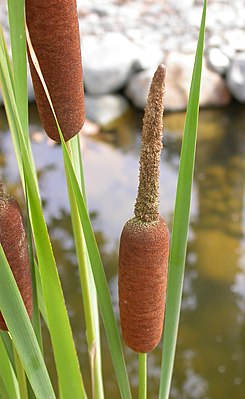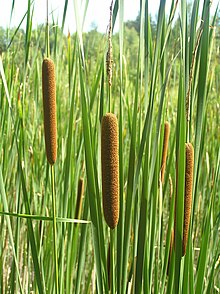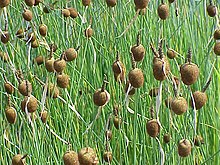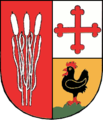Cattail
| Cattail | ||||||||||||
|---|---|---|---|---|---|---|---|---|---|---|---|---|

Broad-leaved cattail ( Typha latifolia ), fruiting |
||||||||||||
| Systematics | ||||||||||||
|
||||||||||||
| Scientific name | ||||||||||||
| Typha | ||||||||||||
| L. |
The cattail ( Typha ), regionally as a cattail , Lampenputzer or Schlotfeger also Schmackedutsche , Bumskeule , Pompesel , Buller broom referred etc., are one of the two genera of the family of typhaceae (Typhaceae) within the order of Süßgrasartigen (Poales).
They are aquatic and marsh plants that can develop dense stands in wetlands . A special feature of the bulrush is the striking two-part inflorescence made up of a purely female-flowered and a purely male- flowered cobs above .
description

Appearance and leaves
Cattail species are deciduous, perennial herbaceous plants . They are aquatic and marsh plants ( hydrophytes , helophytes ) with strong rhizomes that creep underground . They are able to develop dense stands ( polycormons ).
The leaves are alternate and strictly two-lined ( distich ) on the stems, which are always hairless . The sessile, simple leaves grow stiffly upright, can reach a length of up to 4 meters, are linear, grass-like and consist of a spongy, compressible floating tissue. The parallel- veined leaf blades are arched outwards and flat on the inside, so that the cross-section is a semicircle - in contrast to the hedgehog's cob with a triangular leaf cross-section. The leaf sheaths are always open. At the vaginal orifices in the transition to the blade, there are no ligules .
Inflorescences, flowers and fruits
Cattail species are single sexed ( monoecious ). The total inflorescence (inflorescence) of the bulrush consists of a thicker, purely female-flowered and a thinner, purely male-flowered partial inflorescence, separated by a species-specific long stem section. These are designed as cylindrical or spherical pistons in which the individual flowers are densely packed. The inflorescence is never of bracts interspersed (bracts) - in contrast to the types of Hedgehog piston plants . The unisexual, threefold single flowers are huskless. The female flower consists of the flower envelope (a) ( perigone ), which is reduced to a dense wreath of hair and a stalked ovary (c) with a spatulate stigma (d). The two to five stamens (b) of the individual male flowers sitting on a stem are surrounded by a few covering bristles (a). The flowering period of the bulrush extends from May to August.
The distribution unit ( diaspore ) is formed from the achenes , a single-seeded nut fruit with a permanent style and the perigone hairs on the tail (ovary stalk).

ecology
The Typha species are pollinated by the wind ( anemogamy ).
The diaspores spread through the wind ( anemochory ) and water ( hydrochory ). The fine perigone hairs serve as flight or swimming organs. In most species, the seeds leave the fruit shell after prolonged contact with the water, sink and germinate under water ( anaerobically ). In some species they remain in the fruit shell and germinate in the air under aerobic conditions.
The vegetative spread occurs via rhizomes. The Typha TYPES can at suitable locations dense species-poor stocks, so-called reedbeds develop. The Typha species are adapted to damp to wet, sometimes brackish and temporarily flooded habitats. They colonize waterfronts, swamps and moors .
distribution
Typha species are common worldwide from the temperate zones to the tropics ( cosmopolitan ) and common. The Typha species are distributed differently. The broad -leaved cattail ( Typha latifolia ) , for example, is widespread . It occurs in the temperate zones of the northern hemisphere as far as South America and parts of Africa . Other Typha species only colonize a limited area . T. capensis is restricted to an area from Uganda to South Africa or Typha davidiana only to China .
Systematics
The generic name Typha is derived from the Greek word týphos for smoke. It is referred to the brown, smoke-like color of the fruit cobs.
The exact placement of the genus within the order Poales has long been controversial. For example, some authors included the hedgehog genus in the cattail family due to their morphological similarity, while others preferred to keep separate, monogeneric families (Typhaceae and Sparganiaceae). According to the strictly phylogenetically oriented APG III , however, the hedgehog cobs are part of the cattail family.



Species:
The genus Typha includes 16 to 40 species , depending on the author :
- Typha albida Riedl : The home is south-eastern Afghanistan .
- Typha alekseevii Mavrodiev : The homeland is the Caucasus region .
- Typha androssovii Krasnova : The species first described in 2003 occurs in Turkmenistan.
- Narrow-leaved cattail ( Typha angustifolia L. ), occurs in Europe, Asia, North America and North Africa.
- Typha austro-orientalis Mavrodiev : The homeland is southern European Russia and Crimea.
- Typha azerbaijanensis Hamdi & Assadi : The homeland is northwestern Iran .
- Typha capensis (Rohrb.) NEBr. : The range extends from Uganda to southern Africa.
- Typha caspica Pobed. : The homeland is the eastern Transcaucasia .
- Typha changbaiensis M.Jiang Wu & YTZhao : The home is northeastern China.
- Typha davidiana (Kronf.) Hand.-Mazz. : The home is China.
- Typha domingensis Pers. : Si is distributed almost worldwide on all continents in the tropics and subtropics, but occurs in Europe only in the south.
- Typha elephantina Roxb. : The range extends from the Sahara to Yunnan .
- Typha ephemeroida Krasnova : The species first described in 2013 occurs in Mongolia.
- Typha grossheimii Pobed. : The homeland is the Caucasus to Central Asia.
- Typha incana capt. & Dyukina : The species that was only newly described in 2008 occurs from Russian Eastern Europe to Western Siberia .
- Typha joannis Mavrodiev : The range extends from Mongolia to the southwestern Amur area .
- Typha kalatensis Assadi & Hamdi : The homeland of the species first described in 2003 is Iran.
- Typha kamelinii Krasnova : It was first described in 2011 from Tajikistan.
- Typha komarovii Krasnova : It occurs only in Russia's Far East.
- Typha kozlovii Krasnova : The species first described in 2011 occurs in Tajikistan.
- Typha krasnovae Doweld (Syn .: Typha sibirica Krasnova ): It occurs from Eastern Europe to Siberia.
- Broad-leaved cattail ( Typha latifolia L. ), occurs in Europe, Africa, Asia and North, Central and South America.
- Laxmann's cattail ( Typha laxmannii Lepech. ): It is native to Southeastern Europe to Japan.
- Typha linnaei Mavrodiev & Kapit. : It occurs in Eastern European Russia.
- French cattail ( Typha lugdunensis P.Chabert ), occurs in France , Germany and Switzerland and from western Asia to China.
- Dwarf cattail ( Typha minima Funck ex Hoppe ): It occurs from Europe to Mongolia.
- Typha orientalis C.Presl : The range extends from Mongolia to the Philippines and Australasia .
- Typha pallida Pobed. : The range extends from Central Asia to northern China.
- Typha paludosa Krasnova : The species first described in 2016 occurs in Siberia.
- Typha przewalskii Skvortsov : The range extends from Far Eastern Russia to northeast China.
- Shuttleworths cattail ( Typha shuttleworthii W.DJKoch & Sond. , Syn .: Typha persica Ghahr. & Sanei ): It occurs from Europe to Iran.
- Typha sinantropica Krasnova : It occurs in Eastern European Russia.
- Typha sistanica De Marco & Dinelli : Home is Iran.
- Typha subulata Crespo & Pérez-Mor. : The home is Argentina and Uruguay .
- Typha tichomirovii Mavrodiev : Home is European Russia.
- Typha turcomanica Pobed. : The home is Central Asia.
- Typha tzvelevii Mavrodiev : The homeland is the Primorye region .
- Typha valentinii Mavrodiev : The homeland is Azerbaijan .
- Typha varsobica Krasnova : The home is Central Asia.
There are also hybrids:
- Typha × argoviensis Hausskn. ex ash. & Graebn. = Typha latifolia × Typha shuttleworthii : Europe.
- Typha × bavarica Graebn. = Typha angustifolia × Typha shuttleworthii : Europe.
- Typha × gezei Rothm. = Typha angustifolia × Typha domingensis : Southern Europe.
- Typha × glauca Godr. = Typha angustifolia × Typha latifolia : Temperate zones of the northern hemisphere.
- Typha × provincialis A. Camus = Typha domingensis × Typha latifolia : Southern Europe.
- Typha × smirnovii Mavrodiev = Typha latifolia × Typha laxmannii : European Russia.
- Typha × soligorskiensis D. Dubovik = Typha angustifolia × Typha laxmannii : Europe.
- Typha × suwensis T.Shimizu = Typha latifolia × Typha orientalis : Japan.
- Typha × volgensis Krasnova = Typha krasnovae × Typha laxmannii : European Russia.
use
Humans have been using cattails to produce fire since the Paleolithic , as nitrated cattail is highly flammable.
All parts of the plant are edible. The starch- rich rhizomes in particular can be cooked like vegetables. Long before other types of grain were made usable by humans, the starchy rhizomes were apparently processed into flour 30,000 years ago. Up to 8 tons of flour can be obtained from the yields of one hectare of marshland.
Bulrushes are used to purify wastewater in sewage treatment plants and to detoxify soils and sludge. These near-natural processes are summarized under the technical term " phytoremediation ", in which the complex abilities of plants and the microorganisms associated with them in the root area are used. Cattails qualified for cultivation because of their high primary production . They are gaining in importance as a renewable raw material, for example for insulating material, as a peat substitute or building and heating material.
Cattail species are used as decorative planting of ponds in parks and gardens. The dried inflorescences are used in floristry . In this context, the lower, female, thick part of the inflorescence, which is later found and dark brown and looks as if its surface velvety , cattails called.
The bast fibers of some types can be processed into staple fibers.
From the straw, wickerwork can be used for. B. Straw hats are made.
Building material:
In the 2000s, the architect Werner Theuerkorn developed an insulating material from Typha angustifolia by gluing strips of the leaves with magnesite to form panels and initially using them for the renovation of a historic half-timbered house in Nuremberg. In the meantime, several other buildings have been insulated with the 2 to 12 centimeters thick, diffusion-open , capillary-active , sound-absorbing and mold-resistant panels, which are made in a small factory in Schönau (Rottal) in Bavaria, due to the tannins they contain . The Fraunhofer Institute for Building Physics built a hut at its test branch in Holzkirchen (Upper Bavaria) for a long-term test .
Heraldic representation
The coat of arms of the city of Kolbermoor in Bavaria shows three bulrushes standing in the moor with an indication of the Mangfall river . The coat of arms indicates the history and importance of the moor for the place. The place name also refers directly to the cattails.
Coat of arms of Hordorf , Lower Saxony ; The coat of arms of the place Hordorf in Lower Saxony shows with the representation of three cattails and a swivel plow on the reclamation of the swampy terrain (ahd. Hora swamp).
Coat of arms of the municipality of Winnigstedt , Lower Saxony; botanically unsatisfactory representation of the leaves
Coat of arms of the Bad Salzufler district of Retzen , North Rhine-Westphalia
Coat of arms of the municipality of Rohr (Thuringia) - The place name is derived from the reed.
The coat of arms and the name of Groß-Rohrheim indicate the importance of the pipe in the community and its surroundings .
Web links
literature
- R. Kiffmann: Sour grasses, rushes and other grassy plants. Self-published: Rudolf Kiffmann, CH 6994 Aranno / Ti (Switzerland), 1991.
- R. Schätzl, F. Schmitt, U. Wild, H. Hoffmann: Water protection and land use through cattail stocks. In: water management. Volume 11, 2006, pp. 24-27.
- U. Wild, T. Kamp, A. Lenz, S. Heinz, J. Pfadenhauer: Cultivation of Thypa spp. in constructed wetlands for peatland restoration. In: Ecological engineering. Volume 17, 2001, pp. 49-54, doi: 10.1016 / S0925-8574 (00) 00133-6 .
- Kun Sun, David A. Simpson: Typhaceae : Typha. Pp. 160–162 - the same text as the printed work online , In: Wu Zheng-yi, Peter H. Raven, Deyuan Hong (ed.): Flora of China. Volume 23: Acoraceae through Cyperaceae. Science Press and Missouri Botanical Garden Press, Beijing and St. Louis, August 20, 2010, ISBN 978-1-930723-99-3 . (Section description, distribution and systematics).
- The genus Typha in the Flora of North America . (Section description).
- The Typhaceae family with the only genus Typha at DELTA. (Section description).
- Walter Erhardt among others: The big pikeperch. Encyclopedia of Plant Names . Volume 2. Verlag Eugen Ulmer, Stuttgart 2008, ISBN 978-3-8001-5406-7 .
Individual evidence
- ↑ a b Bernd Eberhart: The board from the swamp . In: The time . No. 51 , December 11, 2014, p. 41 ( online since December 29, 2014 ).
- ^ Henry Potonié : Illustrated flora of North and Central Germany. 4th edition. Springer, 1889, ISBN 978-3-642-90261-1 , p. 97, online at biodiversitylibrary.org, accessed July 18, 2019.
- ^ William Foerste : Low German word. Volume 7, Heft 1/2, Aschendorff, 1967, p. 73, online (PDF; 4.91 MB), at lwl.org, accessed on April 14, 2017.
- ^ Franz Dornseiff : The German vocabulary according to subject groups. de Gruyter, 1933, 2013, ISBN 978-3-11-219386-0 (Reprint), p. 102, limited preview in the Google book search.
- ↑ Cattail fact sheet. Cattail section identifying features . In: teichpflanze-teichbau.com. Retrieved July 18, 2019 .
- ↑ Angiosperm Phylogeny Group: An update of the Angiosperm Phylogeny Group classification for the orders and families of flowering plants: APG III. In: Botanical Journal of the Linnean Society. Volume 161, 2009, p. 2, pp. 105-121, doi: 10.1111 / j.1095-8339.2009.00996.x
- ↑ a b c d e f g h i j k l m n o p q r s t u v w x y z aa ab ac ad ae af ag ah ai aj ak al am an ao ap aq ar as at au av aw Rafaël Govaerts (Ed.): Typha. In: World Checklist of Selected Plant Families (WCSP) - The Board of Trustees of the Royal Botanic Gardens, Kew . Retrieved August 15, 2018.
- ↑ Food chemist Udo Pollmer : Transcript of the meal broadcast on November 14, 2010 on Deutschlandradio .
- ↑ Bulrush. In: GartenRatgeber.net. Retrieved July 17, 2019 .
- ^ Heinz Kruschel : Tantalus. Detective novel . EDITION digital, Pinnow 2014, ISBN 978-3-95655-143-7 , pp. 89 ( limited preview in Google Book Search [accessed July 17, 2019]).
- ^ Otto Lueger : Lexicon of the entire technology and its auxiliary sciences. Volume 1, 2nd edition, Stuttgart, Leipzig 1920, p. 647. Typhafaser at Zeno.org .
- ↑ New stable and insulating building material made of cattail (Typha) (PDF; 177 kB), on ibp.fraunhofer.de, accessed on April 14, 2017.








